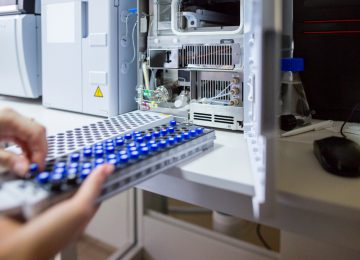

Synergy Health provides Quality Control Testing of formulated finished products, active pharmaceutical ingredients and excipients for the pharmaceutical industry.
No pharmaceutical product can be manufactured without first using raw material analysis to establish the identity, purity and quality of the raw materials to ensure the product is suitable for its intended use. When this critical step in the pharmaceutical manufacturing process is performed successfully, costly production problems and delays can be avoided.
Synergy Health has years of experience performing all types of analysis on active pharmaceutical ingredients, excipients and finished formulations. We offer compendial testing of raw materials, excipients and finished products, Quality Control testing of pharmaceutical products according to Customer-supplied or vendor supplied methodology is also possible.
- Physical and chemical analysis
- Apparent volume
- Conductivity testing
- Density
- Disintegration testing
- Resistance to crushing of tablets
- Friability
- Dissolution testing (apparatus I and II)
- Neutralizing capacity
- Optical rotation of drugs
- Osmotic value
- Particle size (sieve and microscopy)
- Particulate contamination, visible and sub-visible (light obscuration particle count test)
- pH
- Refractive index
- Uniformity of dosage units (mass and content)
- Uniformity of mass
- Viscosity
- Water content of compounds
- Assay
- Related Substances/ impurities testing
- Elemental impurities (trace metals)
Microbiological analysis
- Absence of specific micro-organisms
- Bioburden, TAMC and TYMC
- Endotoxin testing (gel clot method, kinetic turbidimetric method)
- Microbiological assay of antibiotics
- Sterility testing
- Identification of Micro-organisms
Physical and chemical raw material analysis
- Boiling point
- Clarity and degree of opalescence of liquids
- Conductivity
- Degree of coloration of liquids
- Density of solids
- Distillation range
- Drop point
- Elemental analysis (atomic absorption, atomic emission, graphite furnace, hydride system)
- Freezing point
- Identification testing
- Infrared spectrometry
- Limit tests
- Melting point
- Optical rotation
- Osmolality
- pH
- Potentiometric determination of pH
- Refractive index
- Relative density
- Residual testing (sulphated ash and total ash)
- Titration (amperometric, complexometric and potentiometric)
- UV-VIS spectrometry
- Viscosity (capillary and rotating)
- Water determination (loss on drying and Karl Fisher)
Chromatography
- Gas chromatography with FID
- High performance liquid chromatography (HPLC) with UV, PDA, RI detection
- Size exclusion chromatography
- Thin layer chromatography
- Ultra-performance liquid chromatography with UV detection
Assays
- Acid value
- Ester value
- Hydroxyl value
- Iodine value
- Peroxide value
- Saponification value
- Gas chromatography
- High performance liquid chromatography
- Titrations
- Ultra-performance liquid chromatography
Impurities
- Ethylene oxide and dioxan
- Gas chromatography
- High performance liquid chromatography
- Particulate matter
- Residual solvents
- Ultra-performance liquid chromatography
- Atomic absorption, atomic emission, graphite furnace, hydride system
Microbiological analysis
- Absence of specific micro-organisms
- Bioburden, TAMC and TYMC
- Endotoxin testing (gel clot method, kinetic turbidimetric method)
- Microbiological assay of antibiotics
- Sterility testing
- Identification of micro-organisms
Physical and chemical raw material analysis
- Boiling point
- Clarity and degree of opalescence of liquids
- Conductivity
- Degree of coloration of liquids
- Density of solids
- Distillation range
- Drop point
- Elemental analysis (ICP-MS, atomic absorption, atomic emission, graphite furnace, hydride system)
- Freezing point
- Identification testing
- Infrared spectrometry
- Limit tests
- Melting point
- Optical rotation
- Osmolality
- pH
- Potentiometric determination of pH
- Refractive index
- Relative density
- Residual testing (sulphated ash and total ash)
- Titration (amperometric, complexometric and potentiometric)
- UV-VIS spectrometry
- Viscosity (capillary and rotating)
- Water determination (loss on drying and Karl Fisher)
Chromatography
- Gas chromatography with FID
- High performance liquid chromatography (HPLC) with UV/VIS, PDA, RI detection
- Size exclusion chromatography
- Thin layer chromatography
- Ultra-performance liquid chromatography with UV/VIS detection
Assays
- Acid value
- Ester value
- Hydroxyl value
- Iodine value
- Peroxide value
- Saponification value
- Gas chromatography
- High performance liquid chromatography
- Titrations
- Ultra-performance liquid chromatography
Impurities
- Ethylene oxide and dioxan
- Gas Chromatography
- High Performance Liquid Chromatography
- Particulate matter
- Residual solvents
- Ultra-Performance Liquid Chromatography
- ICP-MS, Atomic absorption, atomic emission, graphite furnace, hydride system
Microbiological analysis
- Absence of specific micro-organisms
- Bioburden, TAMC and TYMC
- Endotoxin testing (gel clot method, kinetic turbidimetric method)
- Sterility testing
- Identification of micro-organisms
